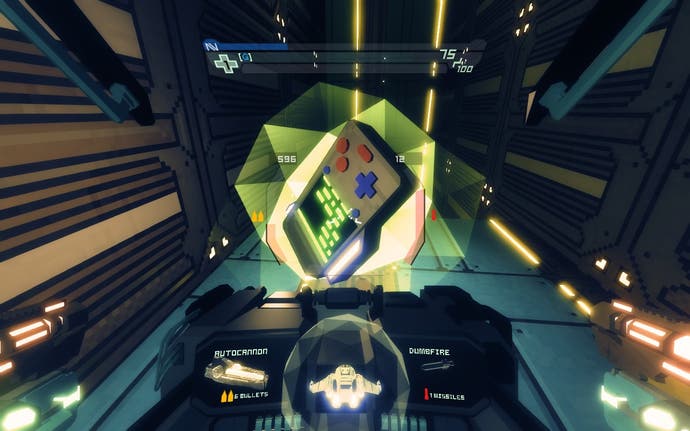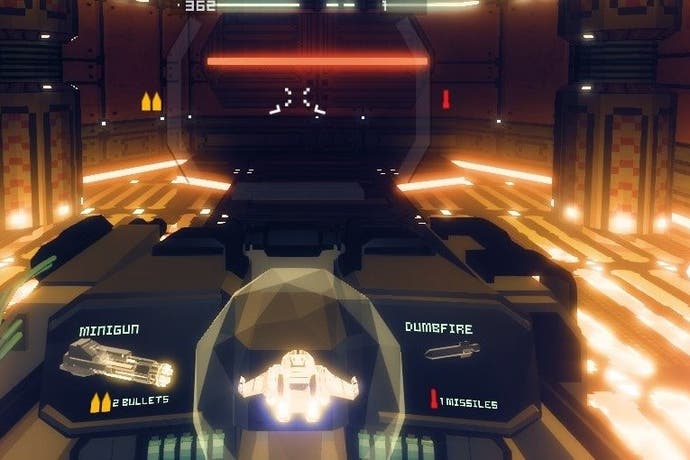Sublevel Zero review
We all float down here.
Of all the pioneering PC games of the early 1990s, when 3D accelerated graphics cards drove gameplay into new dimensions, Parallax Software's 1994 hit Descent stands out as a beloved title that got left behind.
Peers such as Quake would go on to inspire an entire generation, but Descent's free-floating take on first-person action never developed much of a family tree. That means that the scene is ripe for a nostalgic revival so here's Sublevel Zero, scratching an itch that has been left unattended for too long.
It's a 6DOF game, to use the obligatory PC gaming acronym. That means "six degrees of freedom", distinguishing itself from the grunt-in-a-maze FPS formula by putting the player in a floating spacecraft, capable of moving up and down, and even rotating completely, turning levels upside down as you go.
Sublevel Zero returns to that formula, and is set in a future where mankind has been scattered across the universe by something called The Event. It's your job to pilot a craft through the twisting tunnels and cavernous rooms of an abandoned research base to find out what happened. Automated sentries and turrets, as well as natural hazards, stand in your way.

It's not until you start playing Sublevel Zero that you realise how sorely missed this style of play has been. Control is smooth, with astute key bindings and control mapping regardless of whether you opt for keyboard and mouse, or joypad. This is essential, given how easy it is to lose your bearings when concepts such as 'up' and 'down' are thrown into doubt. Give it a few minutes and you'll be skating, feinting and pirouetting down corridors like a seasoned pro.
The game is split into six stages, starting at the basement level of the title. Progress requires you to first find a reactor, then destroy it. This releases a flux drive which triggers a portal to the next level.
It sounds pretty simple, but like so many modern games Sublevel Zero is a permadeath roguelike. The levels mutate every time you play, and every time you die you lose everything you found and must start over from scratch. The only things to persist across playthroughs are different ship types, unlocked by performing certain feats. Defeat 150 enemies by ramming them, for example, and you'll get access to a tougher Berserker chassis. Take 275 points of damage in a level and still survive, and you earn the Tank.
It'll take you a while to be confident enough to earn such treasures, however, so your initial forays must rely on the combat tools on offer at the start. Your ship has four weapon slots - two guns, two missile launchers - and you'll find new additions to your arsenal in chests dotted around each map, and also dropped by defeated enemies. There are also improved engines and hulls to be found.
You can equip them as they are, or you can stockpile them in your limited cargo hold. A collectible currency, Nanites, can be used to combine different weapons into new configurations via a rudimentary crafting system. It's a feature that should represent Sublevel Zero's big addition to its genre, but in practice it's too limited and opaque to really grab your attention. There's little sense of escalation when combining weapons, and the spartan menu means it's too easy to throw away a superior equipped weapon in favour of something weaker.
Combat is punchy and slick, however, and aided by a gorgeous aesthetic that sits somewhere between the modern day and the game's 1990s ancestry. It's bright and chunky, an effect not dissimilar to a first-person take on Geometry Wars. The downside is that enemies and their shots can become lost in the gleams and flares, forcing you to favour an overly cautious approach where hiding and backpedalling are what keep you alive. Health packs are dropped fairly generously, but each refills only a small amount and they do it gradually. Again, tactical use is required.
Enemy types are simple in structure, but shrewdly designed so that you quickly learn to identify each threat. Some will speed towards you, drill bits whirring. Others hang back and snipe, while others let fly with volleys of rockets. You're always learning from each encounter, always learning some new trick that will get you a bit further next time.

It's in the roguelike elements that Sublevel Zero stumbles most obviously. The assets being juggled each time aren't distinctive enough for playthroughs to become memorably different, as the corridors and caverns start to feel familiar very quickly. Nor does the random factor make for a particularly satisfying structure.
This is a genre where constant map-checking is required to reorient yourself, and an excess of diversions and dead-ends thrown up by the game feel more frustrating than enticing. The story is thin enough that narrative consistency doesn't really matter, but there's little sense of exploring an actual location that once had purpose. A little more curated authorship would give each stage a sense of purpose and identity that is currently lacking.
As such, Sublevel Zero's strongest pleasures are experienced in the early going, and in the moment-to-moment of exploring virtual spaces in a way that gaming has neglected for too long. Polished presentation and pin-sharp control underscore that enjoyment.
I'm just not sure how often I'll keep returning to the game, as each restart and replay through a technically different yet largely familiar map chips away at Sublevel Zero's best features, rather than supporting them. With its rock solid gameplay core, though, it would only take tweaked updates to the crafting and roguelike algorithms to easily turn a good game into something great.


